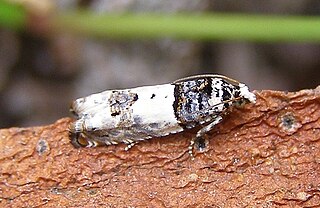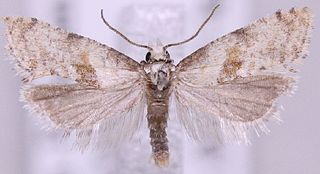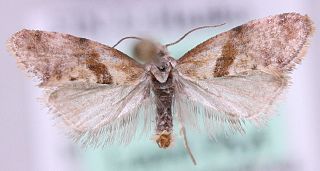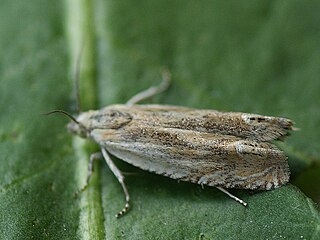
The Cochylini are a tribe of tortrix moths. It used to be classified as the subfamily Cochylinae.

Phalonidia contractana is a moth of the family Tortricidae. It is found in southern Europe, Dalmatia, Macedonia, Hungary, Romania, Bulgaria, Greece, Ukraine, southern Russia (Sarepta), Uralsk, Turkey, Kuldscha, Afghanistan, Kashmir, Lebanon, China, Iran, Pakistan and Kyrgyzstan.

Gypsonoma sociana is a moth of the family Tortricidae. It is found from Europe to Russia, China and Japan.

Rhyacionia pinivorana, the spotted shoot moth, is a moth of the family Tortricidae. It is found from northern and central Europe to eastern Russia, China, Korea and Japan.

Cochylidia is a genus of moths belonging to the family Tortricidae.

Zeiraphera ratzeburgiana, the spruce bud moth or Ratzeburg tortricid, is a moth of the family Tortricidae. It is found from northern and central Europe to eastern Russia and China. Zeiraphera ratzeburgiana is a taxonomically similar species to Zeiraphera canadensis and can only be distinguished by an anal comb found in Z. canadensis.

Cochylidia rupicola, the chalk-cliff tortrix or conch, is a moth of the family Tortricidae.

Cochylidia heydeniana, the blue-fleabane conch, is a moth of the family Tortricidae. It was described by Gottlieb August Wilhelm Herrich-Schäffer in 1851. It is found from most of Europe to China (Xinjiang), Mongolia, Korea, Russia and Japan. The habitat consists of dry pastures, wasteland and sand dunes.

Cochylidia implicitana, the chamomile conch, is a moth of the family Tortricidae. It was described by Wocke in 1856. It is found in most of Europe, except Ireland and most of the Balkan Peninsula. Outside of Europe, it is found in Morocco, the Alatau mountains in Central Asia, Iran and China (Xinjiang). The habitat consists of waste ground and verges.

Cochylidia richteriana is a moth of the family Tortricidae. It was described by Josef Emanuel Fischer von Röslerstamm in 1837. It is found from central and northern Europe to Mongolia, China, the Russian Far East, Korea and Japan.

Cochylidia subroseana, the dingy roseate conch, is a moth of the family Tortricidae. It was described by Adrian Hardy Haworth in 1811. It is found from most of Europe to China, Russia, Korea and Japan. It has also been recorded from North America.
Cochylidia altivaga is a species of moth of the family Tortricidae. It is found in China and Nepal.
Cochylidia contumescens is a species of moth of the family Tortricidae. It was described by Edward Meyrick in 1931. It is found in China, Korea, Japan and Russia.
Cochylidia liui is a species of moth of the family Tortricidae. It is found in Guizhou, China.
Cochylidia multispinalis is a species of moth of the family Tortricidae. It is found in China.
Cochylidia oblonga is a species of moth of the family Tortricidae. It is found in China.

Eupoecilia sanguisorbana is a species of moth of the family Tortricidae. It is found in China, Kazakhstan, Kyrgyzstan and most of Europe.

Eucosma metzneriana, the mugwort bell, is a species of moth of the family Tortricidae. It is found on Sicily and in Great Britain, the Netherlands, Belgium, Luxembourg, France, Germany, Denmark, Austria, Switzerland, Italy, the Czech Republic, Slovakia, Slovenia, Hungary, Bulgaria, Romania, Poland, Sweden, Finland, the Baltic region, Ukraine, Russia, North Africa, Transcaucasia, Asia Minor, Iran, Kazakhstan, Kyrgyzstan, Mongolia, China, Korea and Japan.

Eucosma cana, the hoary bell, is a species of moth of the family Tortricidae.

Eucosma wimmerana is a species of moth of the family Tortricidae. It is found in China, Mongolia, Japan, Russia, Kazakhstan and Europe, where it has been recorded from Sicily, France, the Netherlands, Germany, Austria, Switzerland, Italy, the Czech Republic, Slovakia, Poland, the Baltic region, Slovenia and Romania.















